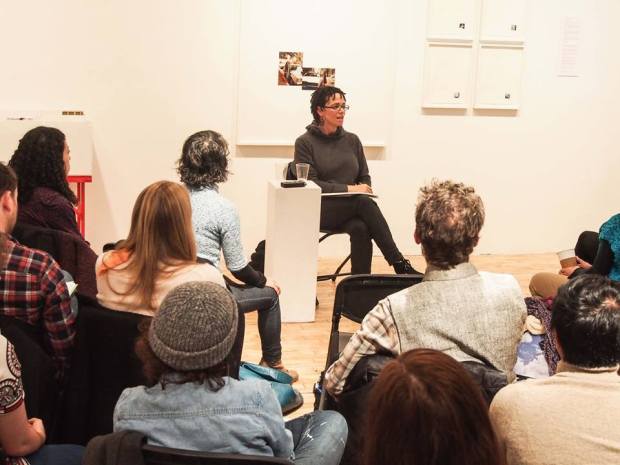
Photo courtesy Noah Fischer
“When I hear people like W.A.G.E. group wanting [artists] to get paid, I’m like, ‘Oh, that’s nice. But what planet do you live on?’”
Those were some of the contentious words artist and MLK visiting professor at MIT Coco Fusco chose to introduce her hour-long talk at Momenta Art earlier this month. The talk, “Creative Extraction: Why are Art Schools at the Vanguard of Unreasonable Debt Burdens?”, was part of a program offered by Occupy Museums that relates to their exhibition and upcoming conference on The Artist as Debtor. It centered around the idea that higher education is a debt trap. Rather than trying to fix the current labor situation, like W.A.G.E., Fusco believes in addressing the root of the problem: art schools and high MFA costs.
W.A.G.E. puts pressure on non-profit institutions to pay standard artist fees. But artists have always been poor, Fusco went on to explain, so small fees won’t help most of them make a living. (Ten percent of arts graduates make a living off art.)
That part of Fusco’s talk, though just a short few minutes, stood out to me. It’s strange, and a little unfair to cut down W.A.G.E. for trying to ensure that non-profit institutions are held to the same standards as any other for-profit institution; workers should be paid.
What I can agree with Coco Fusco on is that student debt, and the culture of art schools, has changed what students can reasonably expect from MFA programs. Here’s just a sampling of art-school abuses Fusco listed off during her talk.
Teaching jobs are few: “What do I have to do to get a teaching job? Blow up a building? I don’t know.”
MFA programs lack standardization: “There is no agreement upon advanced art degrees in this country. There’s very little thinking. It’s a lot of socializing.”
There’s too many degrees: “The proliferation of degrees plays into this. It’s presented as choice, but in fact there’s an economic rationale for this that has to do with sucking up more students into the system.”
On top of that, there’s too many “useless” degrees, ones that don’t require a technical skill set. She noted that social practice MFAs were one of them: “A lot of the newer degrees have to do with talking a lot and not making anything…[If] you don’t have to learn how to stretch a canvas, well, you’ve just lost about 85 percent of the jobs that would have been open to you when you got out.”
But a social practice MFA, which does not deal with the world of art fairs, seems to contradict how, from Fusco’s point of view, making market-ready work as an MFA student is no longer an option—it’s integral to the program. “Basically, you’re paying 50k a year to be looked at,” Fusco said, listing off a litany of dealers, critics, and curators, who perform studio visits with MFA program students.
For Fusco, it’s harder to make work that’s an alternative to the market—or to have that freedom—because students are so tied to debt. (The freedom of being an artist is now only freedom under the constraints of the market.) 30 years ago, the process of completing an MFA degree was seen as a way to escape the market.
Fair enough; MFA programs are now more like farm leagues for some of the blue-chip galleries. But student debt doesn’t wholly explain the market-friendliness of some MFA programs. Though Fusco recalled a story of one administrator telling a potential student that he would make back his tuition once he graduated, I’ve never known anyone to believe that type of spiel. That still doesn’t explain why we have so many painters.
During the Q&A plenty of hands shot up asking for remedies. Fusco said she didn’t have one—what’s important is making the student-debt problem visible—so changes might need to be made by someone else. Until then, we’re left with the current situation: For every single MFA who makes a living off their artwork right after graduation, there’s the hundreds of others left slinging cappuccinos or filing for unemployment. Of course they’re unable to pay off their student loans. This is the new reality we live in.


{ 1 comment }
I did not attend the talk, so I am uncertain if Coco Fusco addressed her role in basically firing 1/3rd of the part-faculty at Parsons in 2009, with a few non-appointments violating the faculty union’s contract:
http://actuaw.org/id131.html
http://nymag.com/daily/intelligencer/2009/03/hard_times_parsons_cuts_13_of.html
Part-time teaching jobs have provided numerous artists a significant portion of their income (as well as benefits in the case at Parsons). I’d take Coco Fusco’s comments on W.A.G.E.’s fee proposal with a grain of salt if she lacks the sensitivity to how many artists’ actually make a living.
Comments on this entry are closed.